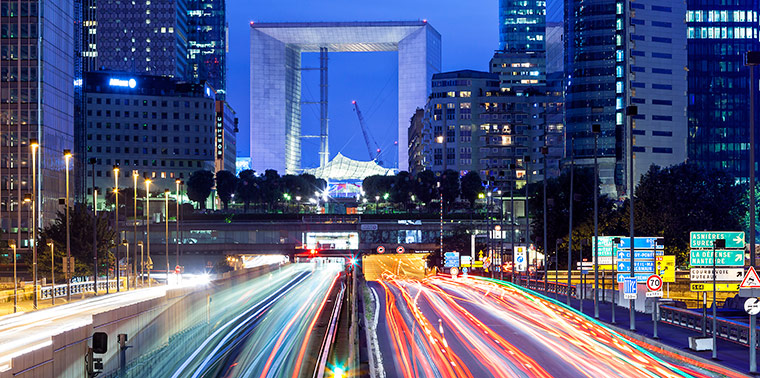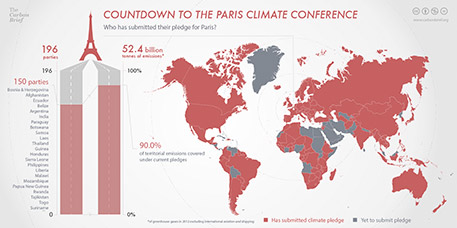October 12, 2015 —  Editor’s note: 2015 is a pivotal year with respect to climate change as growing concern about impacts converges with a critical stage in the decades-long process of shaping an international agreement to alter our trajectory. In preparation for the 21st gathering of the Conference of the Parties to the United Nations Framework Convention on Climate Change (COP 21) in Paris beginning Nov. 30, Ensia is publishing a series of context pieces from longtime observer and reporter Fiona Harvey. This fourth installment provides a look at preparations for the conference and what key questions need to be resolved for the conference to succeed. For more explainers, check out the other features in the series: Everything you always wanted to know about the UN climate talks but were afraid to ask, We’re headed to Paris, but where did we come from? and As we prepare for the UN climate talks, a look at what’s changed since Copenhagen.
Editor’s note: 2015 is a pivotal year with respect to climate change as growing concern about impacts converges with a critical stage in the decades-long process of shaping an international agreement to alter our trajectory. In preparation for the 21st gathering of the Conference of the Parties to the United Nations Framework Convention on Climate Change (COP 21) in Paris beginning Nov. 30, Ensia is publishing a series of context pieces from longtime observer and reporter Fiona Harvey. This fourth installment provides a look at preparations for the conference and what key questions need to be resolved for the conference to succeed. For more explainers, check out the other features in the series: Everything you always wanted to know about the UN climate talks but were afraid to ask, We’re headed to Paris, but where did we come from? and As we prepare for the UN climate talks, a look at what’s changed since Copenhagen.
Scientists agree: we need to reduce our greenhouse gas emissions drastically in the next decade if we are to avoid the worst ravages of climate change. World governments agree: the way to do that is to forge a global agreement at the climate talks scheduled for this November and December in Paris. Such an agreement would run from 2020 to 2030 and beyond, and encompass all the world’s economies, developing and developed, big and small.
With less than two months until that meeting convenes, major issues remain unresolved. Whether they can be settled in the short time available will determine whether Paris is a success — and whether the world can measure up to the major tasks ahead.
A measure of the urgency of the problem is the current refugee crisis in Europe, the Middle East and Africa. Millions of refugees fleeing from Islamic State militias, the civil war in Syria and other unrest have overwhelmed European borders, causing unprecedented turmoil. Several prominent commentators have warned clearly that humanitarian disasters like this are only a foretaste of what is likely as climate change takes hold in the coming decades.
François Hollande, president of France, the host of the climate conference, recently made the comparison devastatingly explicit. “There is a risk of failure,” he told journalists. “If we don’t conclude [with a successful agreement] and there are no substantial measures to ensure the transition [to a climate-affected future], then it won’t be hundreds of thousands of refugees in the next 20 years — it will be millions.”
The key questions at the conference will be over emissions reduction, financial assistance for poor countries to help them cut their emissions and deal with the effects of warming, and long-term planning.
That dire warning notwithstanding, French officials remain publicly optimistic that an agreement this December is likely, though they warn against complacency. The extent to which such an agreement can be deemed a success will depend on whether it is strong or weak. And big questions will need to be answered before we can say whether Paris is likely to end with a strong pact. Will the reductions in emissions that nations have been promising be enough? Will pledges of aid to developing countries facing imminent climate disaster be forthcoming? Will those nations refuse to sign unless they are promised sufficient funding to enable them to curb carbon dioxide and cope with the effects of climate change? What will the role of the private sector be as governments strive for a conclusion? Will there be enough time for the negotiators to slim down an unwieldy text into a manageable form that can be agreed by world leaders?
The key questions at the conference will be over emissions reduction, financial assistance for poor countries to help them cut their emissions and deal with the effects of warming, and long-term planning. Progress is being made on all fronts.
Biggest Issue
The biggest issue to be resolved is emissions reduction. Data tell us that global greenhouse gas emissions are still rising, albeit more slowly than in the past. Paris is meant to resolve that — but the pledges countries have made so far to reduce their own emissions don’t yet add up to the total needed to ensure that the world stays within 2 °C (3.6 °F) of warming scientists urge us to stay within, lest climate change become uncontrollable and associated extreme weather becomes catastrophic.
So far more than 140 countries, including the U.S., Europe, China, India and a variety of other developed and rapidly industrializing economies, have put their emissions pledges on the table. Altogether, pledges already made and likely to be made soon amount to more than 85 percent of global greenhouse gas emissions.
But these pledges, according to U.N. chief climate official Christiana Figueres, still will not bring us to the limits scientists say will be needed to give us more than a 50 percent chance of staying within 2 °C. Estimates based on the pledges now in suggest at least 2.7 °C (4.8 °F) of warming will result.
The good news is that there are ways to increase the impact of any agreement without governments having to revise their pledges. According to the New Climate Economy initiative, the pledges are only part of the equation. If we add to them the actions that have already been agreed, or that could be agreed, from “non-state actors,” we can move close to the amount of carbon reduction needed. These actions include pledges from city, local and other governments, which typically are not included within nationally set goals, and so represent separate action on climate change that could have a major effect. They also include actions promised from businesses that are not captured by the national government plans. For instance, Unilever, General Mills, Nestlé and Mars, Inc., have said they will reduce their emissions unilaterally.
The Matter of Money
Finance, however, remains a major sticking point. Developing countries want richer ones to pledge funding to enable them to cut their emissions — for instance, by funding renewable energy schemes or energy efficiency. These have significant carbon-cutting potential, but poor countries struggle to find the money to invest in them or to provide the incentives necessary for private sector businesses to invest in them. At the Copenhagen climate talks in 2009, developed nations promised US$100 billion per year would flow to the poor world in order to fund such operations.
Rich countries are wary of signing a blank check. They argue that, following the financial crisis and given their existing commitments to poor countries, the prospect of covering the expense from the public purse is out of reach. They point to tens of billions already provided by their governments to sectors as diverse as forestry, city development, technology transfer and other means that reach the same goals, as well as contributions from development banks, which are funded by taxpayers from developed countries.
These sums do not amount to the level promised. But if private sector contributions are factored in, then the finance flows from rich to poor in order to aid climate change–related development can be seen as much more substantial, amounting to the order of gains needed to fulfill the Copenhagen pledges.
A further thorny issue remains, however: the Copenhagen pledges run to 2020, but what will replace them?
This argument has moved on a long way since 2009, when some countries argued that all of the funds should come from taxpayers in developed countries. The Organisation for Economic Co-operation and Development has produced a report saying that US$62 billion of climate finance flowed to developing countries last year, which may be enough to persuade poorer nations that the US$100 billion pledge will be met and sway support for a Paris agreement.
What Next?
A further thorny issue remains, however: the Copenhagen pledges run to 2020, but what will replace them? Will the Paris talks yield a similar round of funding pledges for 2030? Figueres is noncommittal. The World Bank has made it clear it will play a major role in post-2020 funding. Most of the focus from developing countries has been on achieving a pre-2020 settlement. What comes next, if anything, is entirely up for grabs.
Other touchstones, such as the issue of “loss and damage,” may also play a part. Largely ignored for most of the negotiations, this issue — rather nebulous, but relating to whether developed countries should help pay for the costs poor countries incur due to extreme weather — has been much played up by non-governmental organizations in the run-up to the Paris talks. It has not, however, been established how any funding toward such damage should be counted under an international agreement, or whether it should be counted toward disaster funding that developed countries already provide. Developed countries are adamant that any agreement on loss and damage should have no overtones of compensation, but some developing countries and NGOs talk about it in these terms. This could be a confusing issue at the talks.
Protecting the seas could play a major role in staving off climate change, but the U.N. negotiations do not give them much consideration and so this vital item is likely to be left on the sidelines once more.
Forests are another outstanding issue. For many years the talks have included ancillary discussions on REDD+ (essentially an offset scheme that offers carbon credits that fund forestry projects) but these are largely unproductive because no funding mechanism has ever been formally introduced. Developed countries fund action on deforestation largely on an ad hoc basis. Although the mechanism of REDD+ has existed for years, little funding flows through it because there is little incentive for it.
Then there are the oceans. Despite playing a massive role in the climate change picture by absorbing one-third of the heat and carbon dioxide produced by human actions — and also reaching their capacity to do so — they will likely play a very minor part in the discussions. Protecting the seas could play a major role in staving off climate change, but the U.N. negotiations do not give them much consideration and so this vital item is likely to be left on the sidelines once more.
On October 5, the U.N. published its latest draft text of a potential Paris agreement, much slimmed down from previous versions. This is a step forward, because getting the text into shape is a prerequisite to any meaningful agreement, and the unwieldy nature of the draft texts before Copenhagen was a factor in preventing a formal treaty being signed there.
There is still no guarantee that an agreement will be signed in Paris. However, it looks increasingly likely. All of the world’s major greenhouse gas emitters have now submitted post-2020 targets, signaling their commitment to the talks. None of them wants to be blamed for wrecking the process. But getting upward of 190 countries to agree on anything is a daunting task, and whatever is agreed upon will doubtless be attacked as not being enough.
Crucially, though, Paris is not an end point. The agreement now in draft provides for a process of regular review, so commitments can be ratcheted up and progress judged. We have the prospect of many more Paris-style meetings to come. ![]()
Ensia shares solutions-focused stories free of charge through our online magazine and partner media. That means audiences around the world have ready access to stories that can — and do — help them shape a better future. If you value our work, please show your support today.
Yes, I'll support Ensia!


A rather larger issue that this post does not seem to touch upon at all is whether countries will in fact hold to their pledges, and whether the agreement made in Paris will have any "teeth" whatsoever. The past track record is not encouraging; major countries such as Canada (http://globalnews.ca/news/1611000/even-with-proposed-oil-and-gas-emissions-regulations-canada-wont-meet-ghg-target-commissioner/) have blown through their past targets without consequences. It is important for the Paris talks to be more than just political theater and empty promises. How will that be ensured?